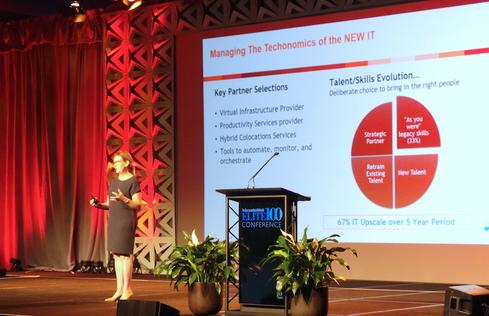Technicolor provides services to content creators and distributors in Hollywood, but the company faced challenges scaling to storage requirements that were projected to grow 100 times over. Here's how the company's new CIO transitioned the organization to embrace elastic cloud-focused services.


6 Secrets 100 Winning IT Organizations Share
6 Secrets 100 Winning IT Organizations Share (Click image for larger view and slideshow.)
Technicolor is a 100-year-old company with a rich history of providing advanced visual services to content creators and distributors in the entertainment industry, but its IT organization was struggling to keep up with the advances the business needed to continue to provide the high-end services required by customers.
When Ginny Davis joined the company as CIO in 2008, she came to an organization where IT had low credibility with the business, in an IT environment with 16,000 servers worldwide in 71 data centers and a 10 to 15 week provisioning cycle for new services. It's no wonder that most servers provisioned were rogue IT and shadow IT, provisioned by users in four weeks.
Davis recounted the challenge faced and how she set out to change the IT organization and serve the business goal of offering "Hollywood-as-a-service" during a session Tuesday, May 5, at the InformationWeek Elite 100 conference in Las Vegas.
Her mission, she said, was to create a dynamic IT business model -- one that enabled pay-as-you-go or pay-as-you-use IT resources. The change was mission-critical, because she projected that the amount of storage required for content would continue to grow over the next 10 years 100 times over. There was no way for capex to keep up with that model, she said.
"Opex was absolutely necessary to keep up with that," she said. "But studios have a lot at stake."
Technicolor's content creation customers are very protective of their intellectual property. So while Technicolor needed to implement dynamic and elastic infrastructure for operational efficiency, it also had to be highly secure.
Davis began the journey by restoring internal IT credibility with users via implementation of a ServiceNow-based help desk that provided them with self-service capabilities. For instance, they could do their own password resets. They could also provision their own services in the cloud with charge backs.
"It let them see a little bit of thought leadership," Davis said. The next step was moving to SaaS applications for functions such as HR and travel. These, too, added credibility.
"So we are not in the living room yet, but we are in the house," Davis said, describing IT's position with the business. "We are part of the game."
Davis continued to work on customer pain points such as the email storage limit.
[Find out more about InformationWeek's Elite 100 2016. Read InformationWeek Elite 100 2016.]
"The whole blocking and not allowing doesn't go over well," she said, describing the change made to the IT organization's philosophy. "If you block, they are going to try to find a way around you anyway."
The transition has been over years, not months. But Technicolor designed a vendor-agnostic cloud platform called Constellation. The whole concept of vendor-agnostic was controversial at the time, Davis said, but necessary. That's because customers had their own vendor preferences and relationships. By supporting all the vendors, Technicolor made sure it could support all its customers.
Technicolor's infrastructure has moved from a big bubble of on-premises technology, together with a colocated private cloud in 2014, to a bigger colocated cloud today with a "bursty" elastic model that enables services to be spun up as needed, and then spun down again when no longer required.
Not everyone on the staff was ready for that kind of change aside from the seven dev-ops people she had hired since she was appointed CIO in 2008, Davis said.
"I had to make some hard decisions to analyze what staff I needed going forward," she said, and over the course of five years Technicolor's IT organization went through a 67% turnover rate. The new organization, however, is primed for what Technicolor needs to be a leader in Hollywood-as-a-service going forward.
"We are looking forward to the next 100 years," Davis said.
About the Author(s)
You May Also Like







